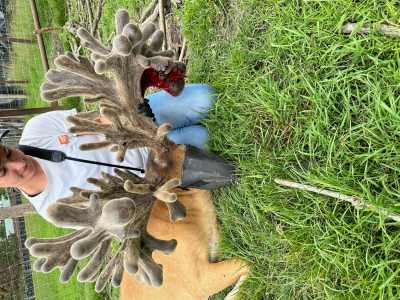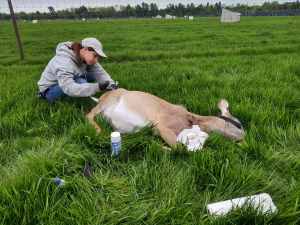Every student studying Environmental Science and Environmental Justice and Sustainability at Bellarmine is required as a part of their degree program to complete an internship for credit. These internships can vary quite a bit in the environmental field, from working in a corporate sustainability office, monitoring and testing waterways, working in a national park, or in the case of Leia Staples, senior Environmental Science major, learning what it takes to work in the field of wildlife conservation and protection.
By Leia Staples
In the summer of 2023, I was accepted to participate in an internship at Gutierrez Cervid Company (GCC) at Legends Ranch in Bitely, Michigan. This unique experience was my dream internship. Every day I was able to observe animal behavior in white-tailed deer. While the deer are kept in captivity, they still have natural instincts and are considered wild animals. Every day, I inspected every buck, doe and fawn for signs of injury or illness.

Bucks commonly have antler injuries and may need to be tranquilized to clean an injury or to cut their antlers off. If left unattended, these injuries can cause death through blood loss or maggots. A bloody antler attracts flies/fly eggs, and maggots cause infection and death. After their antlers are cut, bucks are given infection drugs and dewormed. I learned to place bands to cut off blood flow and feeling, cut off the antlers, cauterize them to stop bleeding, and spray with treatments to prevent infection or short-term bleeding.
For all deer, common illnesses include abscesses, which require an incision and draining plus infection drugs. Pneumonia requires infection drugs and fluids. Hoof rot, which is evidenced by a limp and/or swelling of the hooves, is treated with infection drugs and dousing the hooves with hoof rot spray. Lumpy jaw, an infection and swelling in the jaw, also requires infection drugs. Infection drugs are administered with four injections, including a pain reliever, vitamins and medication to kill infection.
Additionally, I tagged fawns. Tagging allows for the tracking of detailed records of each fawn’s medical history, which involves administering preventative medication for E. coli and spraying iodine to prevent common infections in the hooves and umbilical cord. If a fawn gets E. coli, treatment includes two oral drugs and three injections each day symptoms are present, up to four days. Afterward, two oral medications are given to treat symptoms. At this point, the fawn will either fight off the disease or succumb to it.

I learned how to give injections, restrain a fawn, tranquilize, and treat all the illnesses described above. I learned how to recognize signs of illness. I also learned how to dart deer using certain medications that do not require full tranquilization. This is less stressful for the deer and still provides relief.
I noticed E. coli in one fawn, caught her and gave her the first day of treatment. A couple of weeks later, she had lumpy jaw, which I also treated. Both of these conditions can cause death in a fawn, and I saved her twice.
This experience was truly amazing and unforgettable. I was able to practice animal observation and gain experience with animal treatment. While not every fawn could be saved, I know I played a vital role in ensuring the survival of some of them.